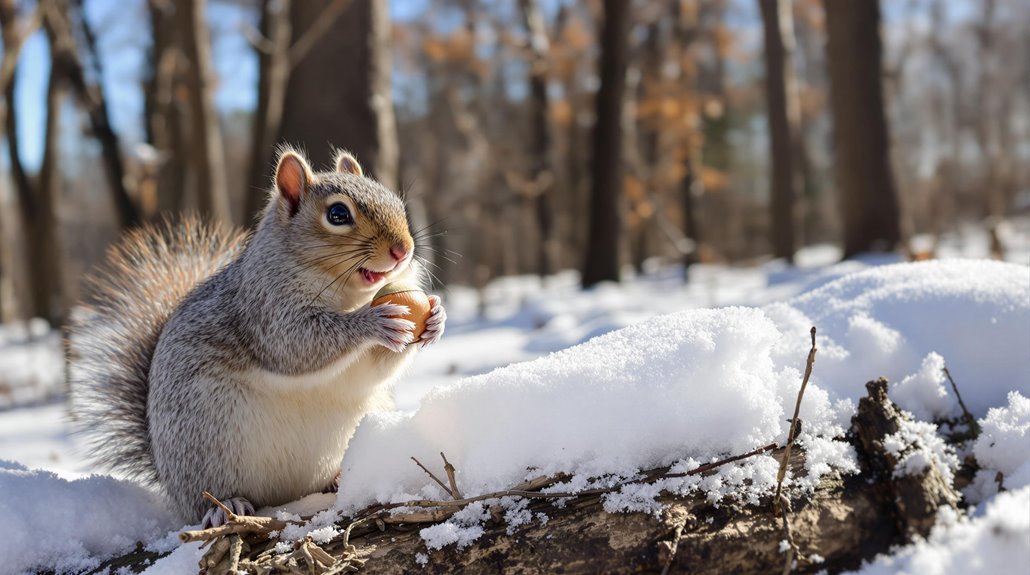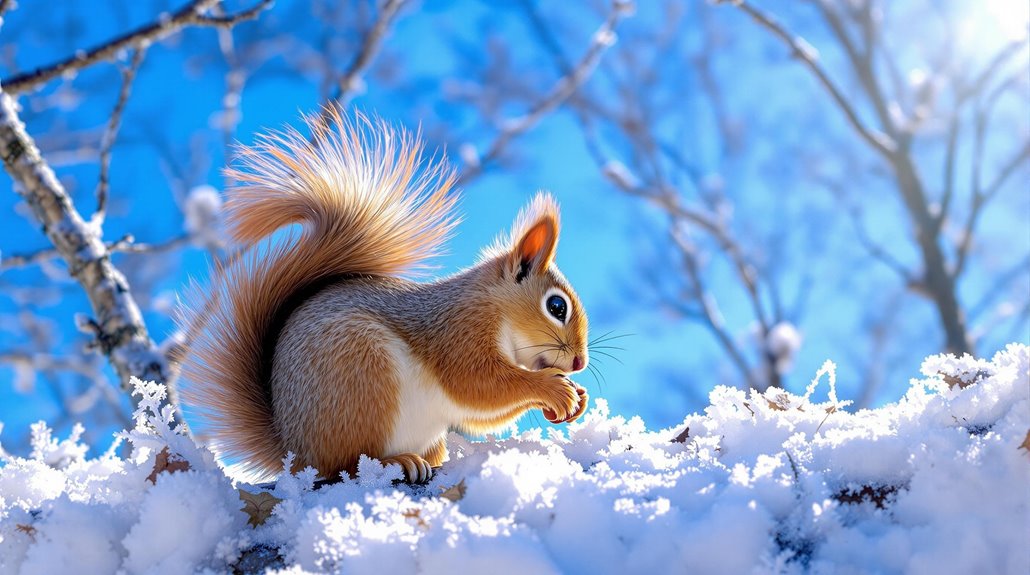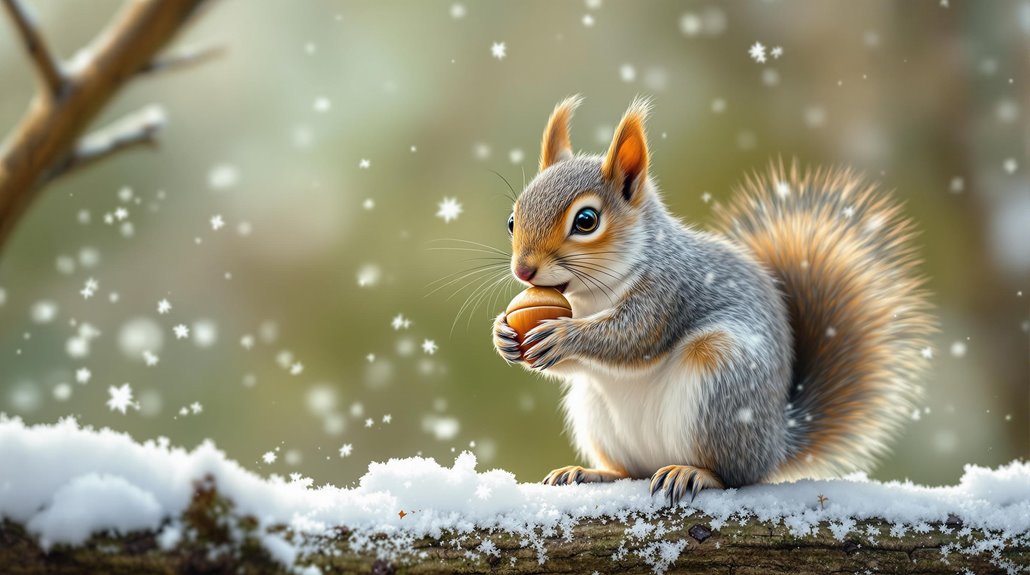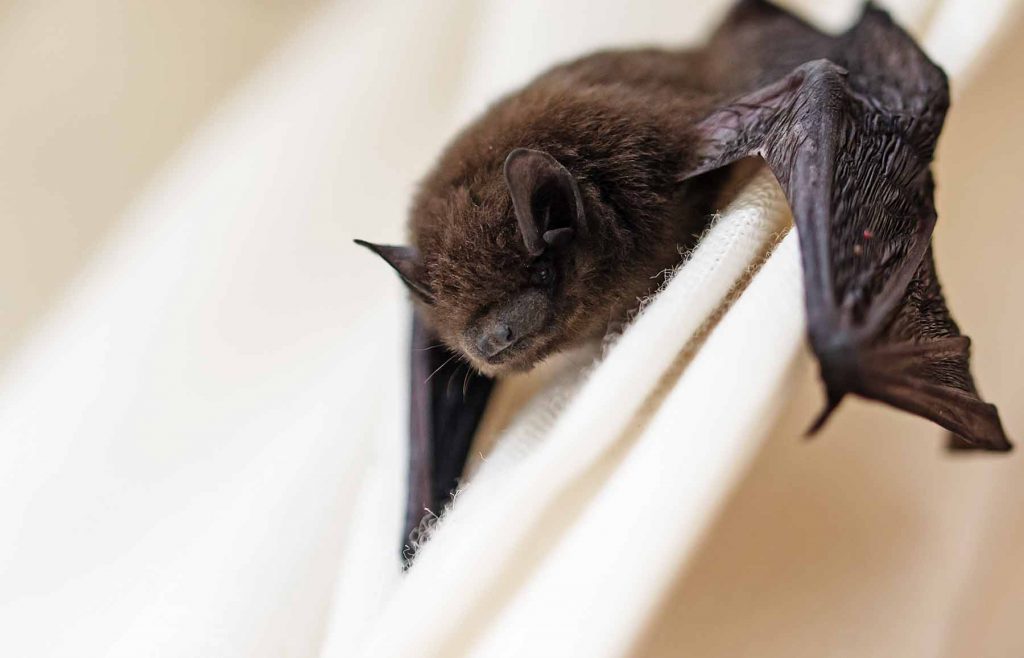During winter in Raleigh, NC, squirrels engage in several key activities that aid their survival. They rely on stored food, such as nuts and seeds, which they buried earlier in the fall. While foraging decreases, squirrels are skilled at retrieving these hidden supplies. Building nests, or dreys, high in trees is essential for warmth and protection from predators. These nests are made from leaves, twigs, and other materials. Additionally, squirrels play important roles in the ecosystem, such as seed dispersal, which promotes new plant growth. There's much more to explore about their fascinating winter habits and ecosystem impact.
Key Article Highlights
- In winter, gray squirrels rely heavily on stored food, decreasing foraging activity as they consume their cached supplies.
- Squirrels construct well-insulated nests, or dreys, using twigs, leaves, and fur for warmth during cold months.
- They maintain excellent spatial memory, allowing them to locate buried nuts and seeds even after months of storage.
- Social interactions among squirrels continue in winter, with vocalizations used to communicate needs and establish social hierarchies.
- Squirrels play a crucial role in the ecosystem by dispersing seeds, which promotes forest growth and supports biodiversity.
Winter Foraging Behaviors
As winter approaches, squirrels adapt their foraging behaviors to guarantee survival during the colder months. These small mammals rely on specific foraging strategies to gather food efficiently. They become more active in searching for nuts, seeds, and other edibles to store for later use. Squirrels often increase their foraging efforts in the fall, when food is more abundant. In North Carolina, the Gray Squirrel is particularly adept at finding and storing food due to the region's diverse habitats.
To prepare for winter, squirrels engage in food storage. They collect and bury nuts in various locations, creating a hidden supply that can sustain them during harsh weather. This behavior not only helps them survive but also supports the ecosystem, as some of these buried nuts may grow into new trees.
Squirrels exhibit a remarkable memory, which aids them in relocating their food caches. Their ability to remember where they buried their food is essential, especially when snow covers the ground. As winter sets in, their foraging activities decrease, and they rely on the food they stored. This adaptation reflects the squirrels' instinctual drive to secure their survival and demonstrates their resilience in the face of changing seasons. Furthermore, their foraging habits can sometimes lead to property risks as they may try to access attics or other sheltered areas for nesting during the winter months.
Nest Building Techniques
Nest building is a essential activity for squirrels during the winter months. As temperatures drop, squirrels seek to create safe and warm spaces to rest and sleep. Their nests, known as dreys, are typically built in trees, taking advantage of various nesting locations that provide shelter from harsh weather and predators.
Squirrels gather nest materials from their surroundings, using twigs, leaves, and moss. They also incorporate softer items like feathers and fur to add insulation. This careful selection of materials helps guarantee that their nests remain cozy during the cold season. The structure of the nest is generally round and well-built, providing a sturdy habitat for the squirrels.
The choice of nesting locations is essential. Squirrels prefer spots that are high in trees, away from the ground, which helps them avoid danger. They often use the same nesting locations year after year, reinforcing the need for a strong and reliable home base.
Through their diligent nest building, squirrels are able to create sheltered environments that support their survival during the winter months, allowing them the freedom to thrive in their natural habitat.
Dietary Adaptations

Dietary adaptations are vital for squirrels during the winter months when food sources become scarce. To survive, these animals employ various nutritional strategies that help them make the most of what they can find. One key strategy is food storage, where squirrels gather and hide food items in preparation for the colder months.
Squirrels are known for:
- Caching: They bury nuts and seeds in multiple locations to guarantee they have access to food later.
- Diverse Diet: They consume a wide range of foods, including fruits, buds, and bark, to adapt to seasonal changes. The Fox Squirrel's importance in the ecosystem is highlighted by its role in seed dispersal and forest regeneration.
- Memory: They rely on their excellent spatial memory to recall where they have stored their food.
The ability to store food not only provides sustenance during winter but also helps squirrels maintain their energy levels. These adaptations are vital for their survival, allowing them to thrive even when conditions are less than ideal. Understanding these dietary habits gives insight into the resilience of squirrels in Raleigh, NC, as they navigate the challenges of winter. Additionally, the need for food storage can lead them to seek shelter in attics, which may result in attic damage prevention issues for homeowners if not addressed promptly.
Social Interactions Among Squirrels
During winter, social interactions among squirrels play a significant role in their survival and overall well-being. These interactions allow squirrels to communicate effectively, forming a strong social network. Squirrel communication includes a range of vocalizations and body language, which helps them express needs and warnings. The establishment of social hierarchies is essential, as dominant squirrels often secure better access to food and shelter.
Playful interactions are common during this season, serving to strengthen bonds between squirrels. Young squirrels often engage in games that develop their skills and social bonds, which are necessary for their development. However, winter can also bring about territory disputes. Squirrels are territorial creatures, and conflicts can arise over food sources or nesting sites. These disputes may lead to aggressive behaviors, but they are usually resolved quickly.
Mating behaviors also become more pronounced in winter as squirrels seek partners for spring breeding. During this time, males may engage in displays of strength and agility to attract females. Overall, these social interactions are essential for squirrels, helping them navigate the challenges of winter and ensuring their survival.
Environmental Impact and Ecosystem Role

Squirrels play an important role in their ecosystems, particularly during the winter months when food is scarce. Their activities greatly influence the local environment, contributing to habitat preservation and supporting various species.
One key aspect of their role is how they affect squirrel population dynamics. As they search for food, squirrels help disperse seeds, which promotes plant growth. This process is essential for maintaining healthy forests and ecosystems. Additionally, their foraging habits create opportunities for other animals to find food, thereby enhancing biodiversity.
The environmental impact of squirrels can be summarized as follows:
- Seed Dispersal: Squirrels bury nuts, some of which grow into new trees, aiding forest regeneration.
- Food Source: They serve as prey for various predators, helping to sustain the food web.
- Nutrient Cycling: Their foraging activities contribute to soil health by breaking down organic matter.
Frequently Asked Questions
Do Squirrels Hibernate During the Winter Months in Raleigh?
Squirrels do not hibernate during winter months. Instead, their behavior adapts for winter survival. They remain active, foraging for food and seeking shelter to endure colder temperatures while managing energy efficiently throughout the season.
How Can I Attract Squirrels to My Backyard in Winter?
To attract squirrels to your backyard in winter, provide squirrel feeding stations with seeds and nuts. Additionally, guarantee nearby winter nesting options, such as trees or nesting boxes, are available to encourage their presence and activity.
Are There Specific Dangers Squirrels Face in Winter?
Approximately 75% of young squirrels do not survive their first winter. During this season, food scarcity poses significant challenges, forcing them to compete for resources, seek shelter, and evade predators, impacting their winter survival.
What Time of Day Are Squirrels Most Active in Winter?
In winter, squirrels are most active during the early morning and late afternoon. Their winter behavior includes foraging and squirrel feeding, as they search for stored food and gather resources to sustain themselves through colder months.
How Can I Identify Different Squirrel Species in Raleigh?
In urban areas like Raleigh, over 90% of squirrels observed exhibit varying behaviors. To identify species, note distinctive characteristics such as fur coloration, tail shape, and size, which reflect unique squirrel behavior across species.

